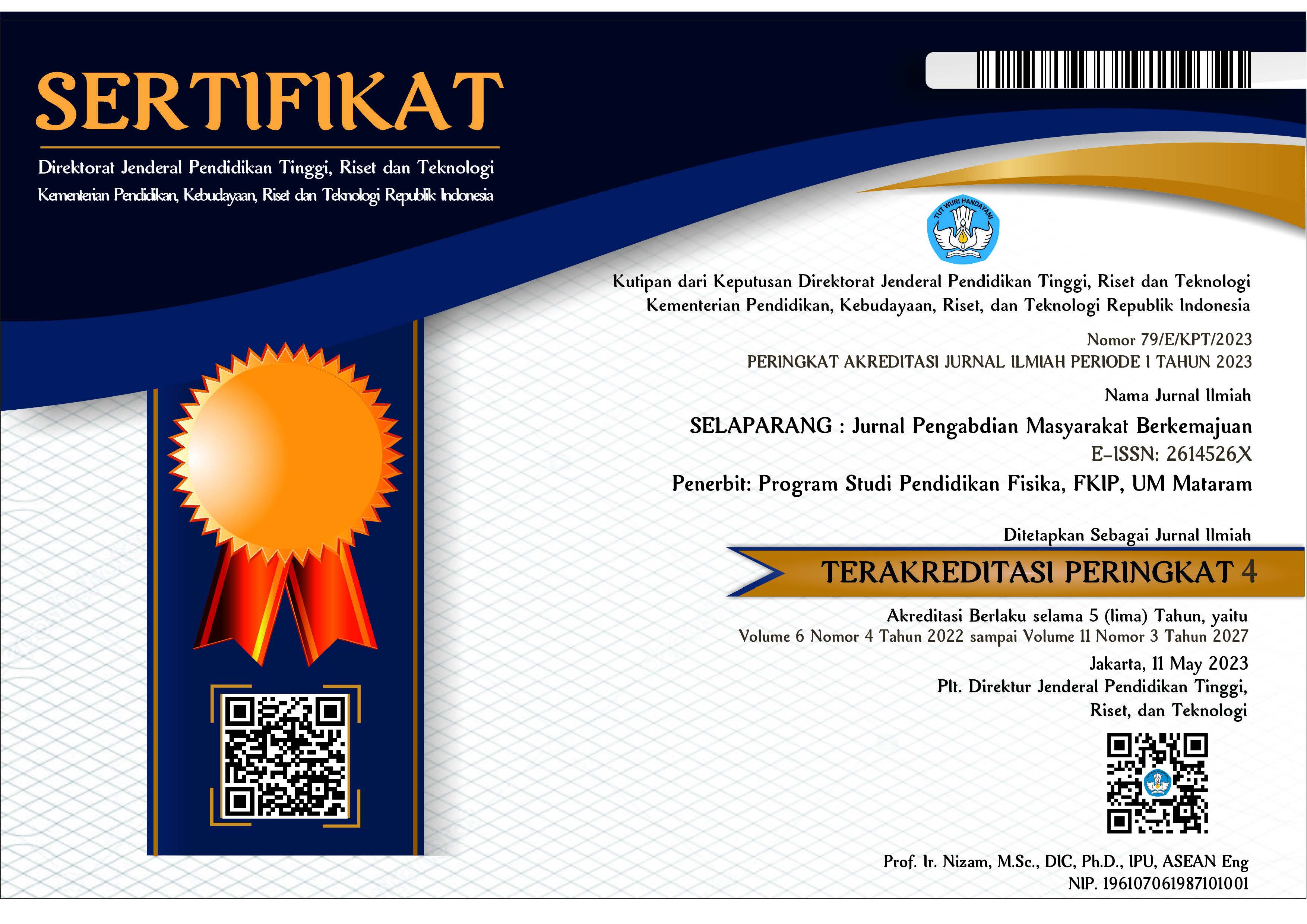PENGGUNAAN KARTU INDEKS BEROBAT PADA FASILITAS PELAYANAN KESEHATAN
Abstract
ABSTRAK
Kebijakan dari pemerintah juga turut memberikan dampak bagi masyarakat, bukan hanya dari aspek ekonomi, melainkan juga dari aspek kesehatan. Salah satu dampak yang cukup dirasakan oleh masyarakat dengan adanya pandemi covid 19 ini adalah terhambatnya akses warga untuk mendapatkan layanan fasilitas kesehatan. Di era seperti ini kesehatan menjadi factor utama yang harus dipenuhi mayoritas penduduk dunia demi harapan hidup yang lebih panjang guna kesejahteraan garis keturunan atau generasi berikutnya, oleh karena itu sering sekali kita menemui sarana pelayanan kesehatan yang ramai dikunjungi orang-orang dari berbagai golongan. Kartu Indeks Berobat (KIB) merupakan kartu identitas milik pasien di suatu instansi pelayanan kesehatan yang berfungsi untuk mencari dokumen rekam medis milik pasien yang sudah berobat di instansi tersebut karena pada kartu berobat pasien terdapat nomor rekam medis pasien. Kegiatan Program Kemitraan Masyarakat ini bertujuan untuk meningkatkan pemahaman kader dan warga terkait penggunaan Kartu Indeks Berobat (KIB). Dengan pengkajian awal terhadap keadaan di lapangan melalui kader dan warga. Pengkajian awal di dapatkan permasalahan bahwa masih kurangnya pemahaman kader dan warga terkait kurangnya pemahaman Kartu Indeks Berobat (KIB) dan belum optimalnya pemahaman fungsi dan penggunaan Kartu Indeks Berobat (KIB) oleh masyarakat. Kegiatan ini dilaksanakan sebanyak 3 kali pertemuan dengan memberikan materi dan diskusi interaktif. Edukasi atau penyuluhan diikuti oleh 25 orang. Dari hasil evaluasi dapat dilihat bahwa terjadi peningkatan nilai antara sebelum dan sesudah penyuluhan. Rata-rata nilai pre test sebesar 20.00 dan nilai post test sebesar 80.00. Kegiatan ini perlu dilakukan sebagai salah satu upaya untuk meningkatkan kesadaran, kepedualian dan mendorong peran kader dan warga untuk tertib membawa kartu indeks berobat (KIB) pada saat berobat di fasilitas pelayanan kesehatan.
Kata Kunci: KIB; Fasyankes
ABSTRACT
Policies from the government also have an impact on the community, not only from the economic aspect, but also from the health aspect. One of the impacts that have been felt by the community due to the COVID-19 pandemic is the obstruction of citizens' access to health facilities. In an era like this, health is the main factor that must be met by the majority of the world's population for a longer life expectancy for the welfare of the lineage or the next generation, therefore we often find health care facilities visited by people from various groups. Medication Index Card (KIB) is an identity card belonging to a patient in a health service agency that functions to find medical record documents belonging to patients who have been treated at the agency because on the patient's treatment card there is a patient's medical record number. This Community Partnership Program activity aims to increase the understanding of cadres and residents regarding the use of the Medication Index Card (KIB). With an initial assessment of the situation in the field through cadres and residents. The initial assessment found the problem that there was still a lack of understanding of cadres and residents regarding the lack of understanding of the Medication Index Card (KIB) and not optimal understanding of the function and use of the Medication Index Card (KIB) by the community. This activity was carried out in 3 meetings by providing interactive material and discussions. Education or counseling was attended by 25 people. From the evaluation results, it can be seen that there was an increase in the value between before and after counseling. The average pre-test value is 20.00 and the post-test value is 80.00. This activity needs to be carried out as an effort to increase awareness, care and encourage the role of cadres and residents to orderly carry a medical index card (KIB) when seeking treatment at health service facilities.
Keywords: KIB; health facilities
Keywords
Full Text:
PDFReferences
Adnyani, N. K. S., & Agustini, D. A. E. (2020). Jpkemas : Jurnal Pengabdian Kepada. Pengabdian Pada Masyarakat, 02(November), 87–96.
Ariyanti, R., Imam, CW. (2021). Edukasi Kesehatan Terkait Upaya Swamedikasi Penyakit Osteoarhtritis Pada Lansia. SELAPARANG Jurnal Pengabdian Masyarakat Ber kemajuan; Vol 4 No 3, Agustus 2021
Haviva, D. N., Rumpiati, & Nurjayanti, D. (2018). Penggunaan Kartu Identitas Berobat (KIB) dalam penyediaan berkas rekam medis pasien rawat jalan di UPT Puskesmas Siman Kabupaten Ponorogo. Global Health Science, 3(3), 245–251.
Herman, J., & Agustina, E. (2020). Hubungan Kepatuhan Pasien Membawa Kartu Indentitas Berobat ( KIB ) di Puskesmas Emparu Tahun 2020 Patient Compliance Relationship Carrying Medical Identity Card ( MIC ) at Emparu Health Center in 2020 Rekam medis merupakan bagian penting pelayanan kepada . 9(4), 545–550.
Kesehatan, E. D. P., & Wariyanti, A. S. (n.d.). Penerapan Kartu Indentitas Berobat ( KIB ) Dalam Pelaksanaan Family Numbering System. 10–14.
Peraturan Pemerintah nomor 47, 2016, Fasilitas Pelayanan Kesehatan, Republik Indonesia
Pratama, R., & Chandra, W. (2019). Analisis Kepedulian Pasien terhadap Kartu Identitas Berobat (KIB) di Puskesmas Tempunak. JUPERMIK (Jurnal Perekam Medis Dan Informasi Kesehatan), 2(Mic), 26–33.
Putri, S. A., Sudalhar, & Pratama, T. W. Y. (2020). Analisa kartu identitas berobat (kib) di bagian pendaftaran uptd puskesmas bojonegoro. Jurnal Hosptal Science, 4(1), 110–113.
Suwarno, A. Y., & Rumpiati, A. D. (2017). Efektivitas Dan Efisiensi Kartu Identitas Berobat (Kib) Di Puskesmas Ngebel Kabupaten Ponorogo. Cakra Buana Kesehatan, 1(1), 1–11.
Yudian, W., & Tri, M. (2020). Penggunaan Kartu Identitas Berobat (Kib) Guna Peningkatan Kualitas Pelayanan Kesehatan Di Puskesmas Ngajum Malang. Pengabdian Kepada Masyarakat, 1(3), 16-21.
DOI: https://doi.org/10.31764/jpmb.v5i1.7524
Refbacks
- There are currently no refbacks.

This work is licensed under a Creative Commons Attribution-ShareAlike 4.0 International License.
______________________________________________________
Jurnal Selaparang
p-ISSN 2614-5251 || e-ISSN 2614-526X
EDITORIAL OFFICE:



















